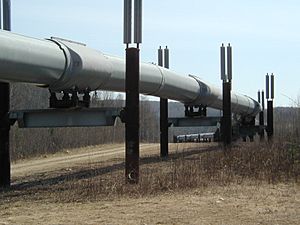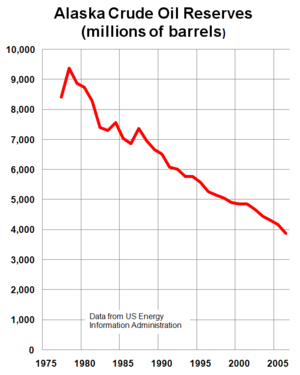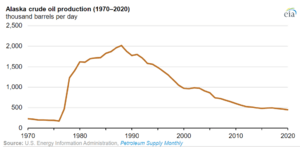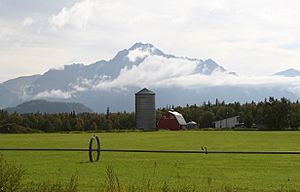Economy of Alaska facts for kids

The Trans-Alaska Pipeline transports oil, Alaska's most important export, from the North Slope to Valdez.
|
|
| Statistics | |
|---|---|
| GDP | $63,618,000,000 |
|
GDP per capita
|
$68,919 |
|
Population below poverty line
|
15.7% |
| .4241 ± 0.0104 | |
|
Labor force
|
364,209 |
| Unemployment | 3.8% |
| Public finances | |
| Revenues | 4,517,927,000 |
| Expenses | 5,437,000,000 |
The economy of Alaska is how people in the state make and spend money. It's all about the jobs, businesses, and resources that keep Alaska going. In 2013, Alaska's total economic output, called its Gross Domestic Product (GDP), was about $51.5 billion. This number went down a bit from 2012 because less oil and gas were produced.
An expert from the University of Alaska Anchorage once said Alaska's economy is like a "three-legged stool." One leg is the oil and gas industry. The second leg is the United States government. The third leg includes all other businesses and services. These three parts work together to create many jobs for Alaskans.
Alaska's main export, after oil and natural gas, is seafood. This includes fish like salmon, cod, pollock, and crab. In 2013, Alaskan fishers caught 5.8 billion pounds of seafood. This was worth about $1.9 billion.
Farming is a very small part of Alaska's economy. Most farms grow things like vegetables and dairy products for people living in the state. Many foods and other goods are brought in from other places. Most jobs in Alaska are in government, getting natural resources, shipping, and transportation. Military bases also provide many jobs in cities like Fairbanks and Anchorage.
Contents
History of Alaska's Economy
Alaska's economy has changed a lot over time. One of the first big steps was in 1878. That year, the first cannery opened. A cannery is a factory that prepares and cans fish, especially salmon. This made it easier to sell Alaskan salmon to people far away.
How Alaska Makes Money: Key Industries
Energy: Oil, Gas, and More
Alaska has huge amounts of energy resources. There are large oil and gas reserves in areas like the Alaska North Slope. Alaska is one of the top states in the U.S. for producing crude oil. The Prudhoe Bay oil field is the biggest in North America. It usually produces about 400,000 barrels of oil each day.
The Trans-Alaska Pipeline is a very important pipeline. It can move up to 2.1 million barrels of crude oil every day. This is more than any other oil pipeline in the U.S. Alaska also has a lot of coal. Experts believe there are also huge amounts of natural gas hidden in ice formations.
Alaska has many rivers, which means it has a lot of potential for hydroelectric power. This is electricity made from moving water. The state's long coastline also has good places for wind power and geothermal energy.
However, many parts of Alaska rely on expensive diesel fuel. This fuel is used for heating, transportation, and electricity. Even though Alaska has lots of wind and water power, it's been hard to build statewide energy systems. This is because of the long distances and small population. Gas prices in Alaskan cities are usually higher than the national average. In rural areas, prices can be much higher due to transportation costs.
In 2012, Alaska produced 8.1% of America's crude oil. Other states like Texas and North Dakota produced more.
Tourism: Visitors Bring Business
Tourism is a very important part of Alaska's economy. It is the second-largest private employer in the state. This means it creates many jobs. Almost 2 million visitors come to Alaska each year. They spend about $2.42 billion.
Many visitors arrive by cruise ship. Some popular cruise lines include Carnival Cruise Line and Princess Cruises. Other visitors fly into the Ted Stevens Anchorage International Airport. Some drive along the Alaska Highway. Others come by ferry on the Alaska Marine Highway.
Tourism helps the state government by paying taxes. For example, cruise ships pay a tax for each passenger. There are also taxes on rental cars and hotel rooms.
A study showed that visitors spend their money on many things. About one-fifth of their spending goes to lodging, tours, gifts, and food. The rest is spent on travel packages and transportation.
People visit Alaska for its amazing nature. They love the vast landscapes, wildlife, and unique culture. Many guided activities help visitors experience these things. These include sightseeing tours, whale watching, and glacier viewing. Other popular activities are flightseeing, wildlife viewing, hiking, and fishing. Fishing alone brings in over $650 million each year from non-residents.
Alaska's National Parks are also a top destination. There are 24 national park areas in Alaska. About 2.6 million people visit these parks each year. These visits add about $1.1 billion to the economy.
Agriculture: Farming in the Far North
Farming is not very common in Alaska. This is because of the cold climate and mountains. Most farms are in the Matanuska Valley, near Anchorage. Some are also on the Kenai Peninsula. The growing season is short, about 100 days. But the long, sunny summer days help crops grow well. Farmers mostly grow potatoes, carrots, lettuce, and cabbage. You can see these crops at the Alaska State Fair. The slogan "Alaska Grown" promotes local produce.
Alaska has a lot of seafood. The main fishing areas are in the Bering Sea and the North Pacific Ocean. Seafood is often cheaper in Alaska than in other states. Many Alaskans fish in rivers during salmon season. They catch a lot of fish for their families to eat. This is called subsistence fishing.
Hunting is also common, especially in remote areas. People hunt animals like caribou, moose, and Dall sheep for food. A traditional food is Akutaq, also known as Eskimo ice cream. It can be made with reindeer fat, seal oil, dried fish, and local berries.
Reindeer farming mostly happens on the Seward Peninsula. This helps keep wild caribou separate from the farmed reindeer.
Most food in Alaska comes from "Outside" (other states). Shipping costs make food expensive in cities. In rural areas, food can be extremely expensive. This is why hunting and gathering are so important there. Bringing one gallon of milk to some villages can cost about $3.50. Fuel can cost over $8.00 per gallon.
Alaska Permanent Fund: A Special Savings Account
The Alaska Permanent Fund is like a big savings account for the state. It was started in 1976. Its purpose was to manage extra money from oil revenues. The fund started with $734,000. Now, it has grown to about $40 billion. This growth comes from oil money and smart investments.
Since 1982, money from the fund's growth has been paid to eligible Alaskans every year. These payments are called dividends. The amount changes each year. For example, in 1984, it was $331.29. In 2008, it was $3,269.00. To get a payment, you must have lived in Alaska for at least 12 months. You also need to keep living there.
Each year, the state government takes out 8% of the fund's earnings. Three percent goes back into the main fund to protect it from inflation. The remaining 5% is given to all Alaskans who qualify.
Cost of Living in Alaska
The cost of living in Alaska has often been higher than in other states. This has changed somewhat in Anchorage and Fairbanks. Prices have gone down a bit in the last five years. However, it is still one of the most expensive places to live.
Big stores like Walmart and Costco have helped lower prices in cities. But in rural Alaska, food and goods are still very expensive. This is because it costs a lot to transport things there. Many people in rural areas buy food in bulk from warehouse stores. Some also use online stores that offer free shipping. This helps them get items cheaper than they could locally.
|




